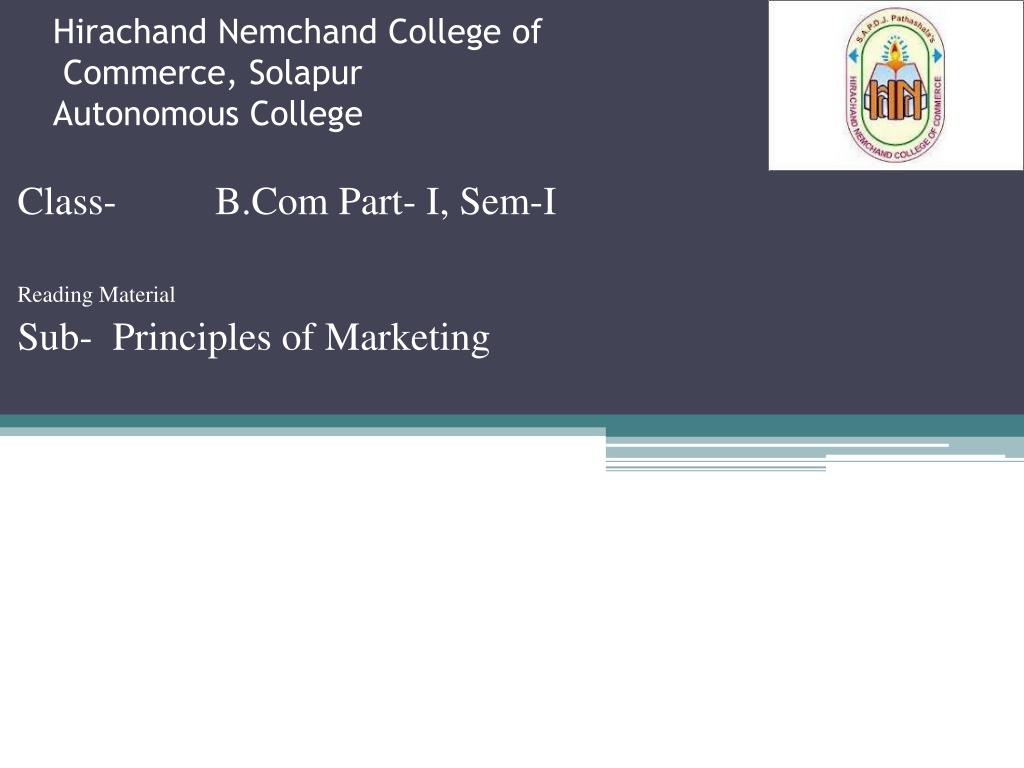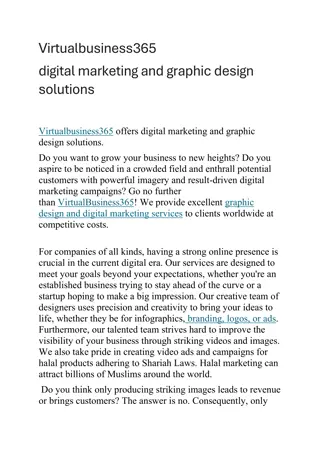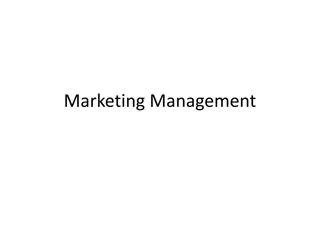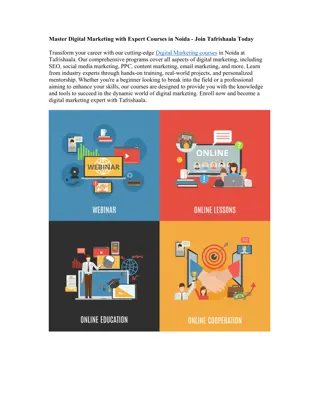Introduction to Principles of Marketing
This reading material delves into the history, definitions, nature, and scope of marketing. It covers how human needs drive exchange, the educational function of marketing, creating and serving consumer demand, and the core principles outlined by Philip Kotler.
Download Presentation

Please find below an Image/Link to download the presentation.
The content on the website is provided AS IS for your information and personal use only. It may not be sold, licensed, or shared on other websites without obtaining consent from the author.If you encounter any issues during the download, it is possible that the publisher has removed the file from their server.
You are allowed to download the files provided on this website for personal or commercial use, subject to the condition that they are used lawfully. All files are the property of their respective owners.
The content on the website is provided AS IS for your information and personal use only. It may not be sold, licensed, or shared on other websites without obtaining consent from the author.
E N D
Presentation Transcript
Hirachand Nemchand College of Commerce, Solapur Autonomous College Class- B.Com Part- I, Sem-I Reading Material Sub- Principles of Marketing
Marketing Introduction: History of Human Civilization Exchange is the central theme Need is the driving force for all types of transactions Human wants are multiple, unlimited, innumerable, variable and recurring. Needs are transformed in to wants Wants generate demand https://www.manbiz.com- Picture
Definitions Kotler: Marketing is a human activity directed at satisfying needs and wants through exchange processes . American Marketing Association Marketing is the activity, set of institutions, and processes for creating, communicating, delivering, and exchanging offerings that have value for customers, clients, partners, and society at large . (Approved 2017)
Nature and Scope of Marketing Distributive Focus Demand- Before and after the Industrial Revolution Radical changes Production stared in anticipation of demand. Mass production, uniform quality Need for extra effort was felt Potential Market
Nature and Scope of Marketing In present days Marketing is thought to perform certain educative function besides economic and social function. Scope of Marketing It starts from making a thinking about consumption and covers different important business activities relating to production, pricing, distribution, profit making and development of organization`s goodwill.
Nature and Scope of Marketing Discovering customer needs Translating these needs in to suitable products and services Creating demand for these products and services Serving the consumer demand Expanding the market.
Nature and Scope of Marketing Philip Kotler explains: Understanding, delivering customer value and satisfaction are at the very heart of Modern Marketing, thinking and practice. creating, communicating, and Right from the conceptualization to After sales service
Importance of Marketing A) As a Business Function -Provides direction to selling efforts -Creation and Retention of customers - Develops new products and new markets - Higher returns - Survival and future growth - To overcome competition
Importance to Economy and Society Brings economic value to products and services Employment Encouragement to Enterprise Boost to Entrepreneurship Development of allied services Encouragement to Investment Speed up the process and rate of economic development. Marketing has educative value Marketing develops new consumption pattern
Meaning of Marketing Environment: The marketing environment refers to all internal and external factors, which directly or indirectly influence the organization s decisions related to marketing activities..
Internal factors are within the control of an organization; whereas, external factors do not fall within its control. The external factors include government, technological, economical, social, and competitive forces; whereas, organization s strengths, weaknesses, and competencies form the part of internal factors. Marketers try to predict the changes, which might take place in future, by monitoring the marketing environment. These changes may create threats and opportunities for the business. With these changes, marketers continue to modify their strategies and plans
A marketing environment mostly comprises of the following types of environment: 1. Micro Environment 2. Macro Environment
1. Micro Environment: Micro environment refers to the environment, which is closely linked to the organization, and directly affects organizational activities. It can be divided into supply side and demand side environment. Supply side environment includes the suppliers, marketing intermediaries, and competitors who offer raw materials or supply products. On the other hand, demand side environment includes customers who consume products.
Micro Environment Suppliers Marketing Intermediaries Customers Competitors
Macro Environment Macro environment involves a set of environmental factors that is beyond the control of an organization. These factors influence the organizational activities to a significant extent. Macro environment is subject to constant change. The changes in macro environment bring opportunities and threats in an organization.
Macro Environment Demographic Environment Economic Environment Natural Environment Socio-Cultural Environment Technological Environment
Market segmentation Market segmentation is one of the most efficient tools for marketers to cater to their target group. It makes it easier for them to personalize their campaigns, focus on what s necessary, and group similar consumers to target them in an effective manner.
What Is Market Segmentation? Market segmentation is a process of dividing the market of potential customers into smaller and more defined segments on the basis of certain shared characteristics like demographics, interests, needs, or location. The member of these groups share similar characteristics and usually have one or more than one aspect common among them which makes it easier for the marketer to craft marketing communication messages for the entire group.
There are many reasons as to why market segmentation is done. One of the major reasons marketers segment market is because they can create a custom marketing mix for each segment and cater them accordingly.
Importance Of Market Segmentation Companies often deal with customers who belong to different age groups, have varied interests, and are motivated by different triggers. Segmenting these potential customers into different groups Makes it easier for the marketer to develop a different marketing mix for each customer segment which is more likely to bring results. Increases the results of the marketing efforts as each of the groups witness personalized marketing messages according to what stimulates them to do the task.
Bases of Market Segmentation Bases Of Market Segmentation Segmenting is dividing a group into subgroups according to some set bases. These bases range from age, gender, etc. to psychographic factors like attitude, interest, values, etc Gender Age Group Income Place Occupation Usage Lifestyle
Types Of Market Segmentation Geographic Segmentation Demographic Segmentation Behavioural Segmentation Psychographic Segmentation Nature of A Market Segment
Benefits Of Market Segmentation Segmenting the market offers the following benefits to the businesses Better Matching Of Customer Needs: Different customers have different needs. By segmenting the target market and developing homogeneous groups, it becomes easier for the marketer to cater to the customer needs better. Identification Of Gaps In The Market: Market segmentation also results in the identification of target groups that are not targeted well in the market. This opens up opportunities for the business to exploit and make profits from.
Benefits Of Market Segmentation Increased ROI: Since market segmentation helps serve the customer needs better, it not only decreases spending unnecessarily but it increases repeated sales, and customers also return the favour in the form of referrals, word of mouth, etc. Customer Retention: Customers retain with a business which understands their needs and fulfils them as they require. Segmentation helps in this. Increased Market Share: Through market segmentation and targeted communication, a competitive advantage can be built which results in increased market share.
Packaging Features 1. 2. 3. 4. 5. 6. 7. 8. 9. 10. Design 11. Distribution (Transport) 12. Differentiation 13. Communication with Customer 14. How to use the products Good Presentation Protection goods Safety Advertisement Attract customers Increase durability Ingredients Manufacture and Expiry Date Branding
Product Life Cycle Every product has a definite life and in business through the various stages of the product life cycle. So we measure its performance and success rate in the market. Basically in which it would show different levels of sales and profit.
Stages of Product Life Cycle Product Development Introduction Growth Maturity Decline
Green Marketing Green marketing involves companies promoting their products or services in a way that showcases their eco- friendliness. Alternate name: Eco-marketing, environmental marketing When a company showcases its eco-friendliness, that may include products: Manufactured in a sustainable fashion Not containing toxic materials or ozone-depleting substances Produced from recycled materials or able to be recycled Made from renewable materials Not making use of excessive packaging Designed to be repairable and not thrown away
Green Marketing Consumers who prefer to purchase green products even though they might be more expensive fall into the LOHAS category. LOHAS stands for Lifestyles of Health and Sustainability. According to Wikipedia: LOHAS describes an integrated, rapidly growing market for goods and services that appeal to consumers whose sense of environmental and social responsibility influences their purchase decisions.

 undefined
undefined

































